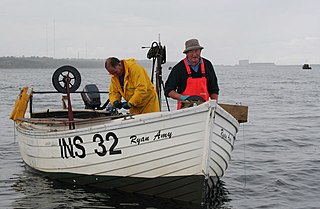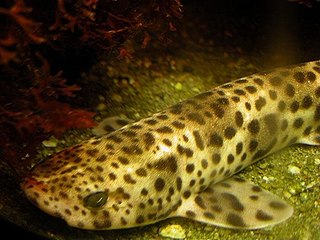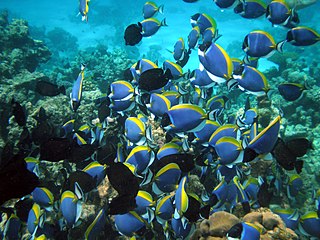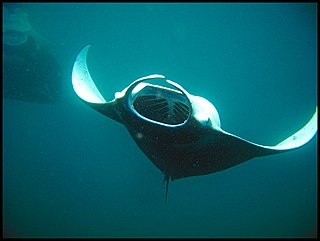
Predation is a biological interaction where one organism, the predator, kills and eats another organism, its prey. It is one of a family of common feeding behaviours that includes parasitism and micropredation and parasitoidism. It is distinct from scavenging on dead prey, though many predators also scavenge; it overlaps with herbivory, as seed predators and destructive frugivores are predators.

Longline fishing, or longlining, is a commercial fishing angling technique that uses a long main line with baited hooks attached at intervals via short branch lines called snoods or gangions. A snood is attached to the main line using a clip or swivel, with the hook at the other end. Longlines are classified mainly by where they are placed in the water column. This can be at the surface or at the bottom. Lines can also be set by means of an anchor, or left to drift. Hundreds or even thousands of baited hooks can hang from a single line. This can lead to many deaths of different marine species. Longliners – fishing vessels rigged for longlining – commonly target swordfish, tuna, halibut, sablefish and many other species.
A Lévy flight is a random walk in which the step-lengths have a stable distribution, a probability distribution that is heavy-tailed. When defined as a walk in a space of dimension greater than one, the steps made are in isotropic random directions. Later researchers have extended the use of the term "Lévy flight" to also include cases where the random walk takes place on a discrete grid rather than on a continuous space.

The basking shark is the second-largest living shark and fish, after the whale shark. It is one of three plankton-eating shark species, along with the whale shark and megamouth shark. Typically, basking sharks reach 7.9 m (26 ft) in length. It is usually greyish-brown, with mottled skin, with the inside of the mouth being white in colour. The caudal fin has a strong lateral keel and a crescent shape. Other common names include bone shark, elephant shark, sailfish, and sunfish. In Orkney, it is called hoe-mother, meaning "the mother of the picked dogfish."

The lemon shark is a species of shark from the family Carcharhinidae and is classified as a Vulnerable species by the International Union for the Conservation of Nature. Lemon sharks can grow to 3.4 metres (11 ft) in length. They are often found in shallow subtropical waters and are known to inhabit and return to specific nursery sites for breeding. Often feeding at night, these sharks use electroreceptors to find their main source of prey, fish. Lemon sharks enjoy the many benefits of group living such as enhanced communication, courtship, predatory behavior, and protection. This species of shark gives birth to live young, and the females are polyandrous and have a biennial reproductive cycle. Lemon sharks are not thought to be a large threat to humans; there have been 10 recorded bites, none of which were life-threatening. The lemon shark's life span is unknown, but the average shark is 25 to 30 years old.

Alepisaurus ferox, also known as the long snouted lancetfish, longnose lancetfish, or cannibal fish, is a species of lancetfish found in the ocean depths down to 1,830 m (6,000 ft). This species grows to 215 cm (85 in) in total length and a weight of 9 kg (20 lb).

An apex predator, also known as a top predator, is a predator at the top of a food chain, without natural predators of its own.

Aposematism is the advertising by an animal to potential predators that it is not worth attacking or eating. This unprofitability may consist of any defenses which make the prey difficult to kill and eat, such as toxicity, venom, foul taste or smell, sharp spines, or aggressive nature. These advertising signals may take the form of conspicuous coloration, sounds, odours, or other perceivable characteristics. Aposematic signals are beneficial for both predator and prey, since both avoid potential harm.

The nursehound, also known as the large-spotted dogfish, greater spotted dogfish or bull huss, is a species of catshark, belonging to the family Scyliorhinidae, found in the northeastern Atlantic Ocean. It is generally found among rocks or algae at a depth of 20–60 m (66–197 ft). Growing up to 1.6 m (5.2 ft) long, the nursehound has a robust body with a broad, rounded head and two dorsal fins placed far back. It shares its range with the more common and closely related small-spotted catshark, which it resembles in appearance but can be distinguished from, in having larger spots and nasal skin flaps that do not extend to the mouth.

One of the first shark species to be protected was the grey nurse shark. The biology, distribution and conservation of this species are dealt with in the following paragraphs with a main focus on Australia as it was here it first became protected.

Diel vertical migration (DVM), also known as diurnal vertical migration, is a pattern of movement used by some organisms, such as copepods, living in the ocean and in lakes. The adjective "diel" comes from Latin: diēs, lit. 'day', and refers to a 24-hour period. The migration occurs when organisms move up to the uppermost layer of the water at night and return to the bottom of the daylight zone of the oceans or to the dense, bottom layer of lakes during the day. DVM is important to the functioning of deep-sea food webs and the biologically-driven sequestration of carbon.
Marine larval ecology is the study of the factors influencing dispersing larvae, which many marine invertebrates and fishes have. Marine animals with a larva typically release many larvae into the water column, where the larvae develop before metamorphosing into adults.

The environmental impact of fishing includes issues such as the availability of fish, overfishing, fisheries, and fisheries management; as well as the impact of industrial fishing on other elements of the environment, such as bycatch. These issues are part of marine conservation, and are addressed in fisheries science programs. According to a 2019 FAO report, global production of fish, crustaceans, molluscs and other aquatic animals has continued to grow and reached 172.6 million tonnes in 2017, with an increase of 4.1 percent compared with 2016. There is a growing gap between the supply of fish and demand, due in part to world population growth.
Fractal analysis is assessing fractal characteristics of data. It consists of several methods to assign a fractal dimension and other fractal characteristics to a dataset which may be a theoretical dataset, or a pattern or signal extracted from phenomena including topography, natural geometric objects, ecology and aquatic sciences, sound, market fluctuations, heart rates, frequency domain in electroencephalography signals, digital images, molecular motion, and data science. Fractal analysis is now widely used in all areas of science. An important limitation of fractal analysis is that arriving at an empirically determined fractal dimension does not necessarily prove that a pattern is fractal; rather, other essential characteristics have to be considered. Fractal analysis is valuable in expanding our knowledge of the structure and function of various systems, and as a potential tool to mathematically assess novel areas of study. Fractal calculus was formulated which is a generalization of ordinary calculus.
Enrico Gennari is an Italian marine biologist who specialises in the study of the great white shark.

In biology, any group of fish that stay together for social reasons are shoaling, and if the group is swimming in the same direction in a coordinated manner, they are schooling. In common usage, the terms are sometimes used rather loosely. About one quarter of fish species shoal all their lives, and about one half shoal for part of their lives.
The Lévy flight foraging hypothesis is a hypothesis in the field of biology that may be stated as follows:
Since Lévy flights and walks can optimize search efficiencies, therefore natural selection should have led to adaptations for Lévy flight foraging.

A planktivore is an aquatic organism that feeds on planktonic food, including zooplankton and phytoplankton. Planktivorous organisms encompass a range of some of the planet's smallest to largest multicellular animals in both the present day and in the past billion years; basking sharks and copepods are just two examples of giant and microscopic organisms that feed upon plankton. Planktivory can be an important mechanism of top-down control that contributes to trophic cascades in aquatic and marine systems. There is a tremendous diversity of feeding strategies and behaviors that planktivores utilize to capture prey. Some planktivores utilize tides and currents to migrate between estuaries and coastal waters; other aquatic planktivores reside in lakes or reservoirs where diverse assemblages of plankton are present, or migrate vertically in the water column searching for prey. Planktivore populations can impact the abundance and community composition of planktonic species through their predation pressure, and planktivore migrations facilitate nutrient transport between benthic and pelagic habitats.

Sir Ian Lamont Boyd, is a Scottish zoologist, environmental and polar scientist, former Chief Scientific Adviser at the Department for Environment, Food and Rural Affairs (DEFRA) and is a professor of biology at the University of St Andrews. He is Chair of the UK Research Integrity Office and President of the Royal Society of Biology.

Baited remote underwater video (BRUV) is a system used in marine biology research. By attracting fish into the field of view of a remotely controlled camera, the technique records fish diversity, abundance and behaviour of species. Sites are sampled by video recording the region surrounding a baited canister which is lowered to the bottom from a surface vessel or less commonly by a submersible or remotely operated underwater vehicle. The video can be transmitted directly to the surface by cable, or recorded for later analysis.















